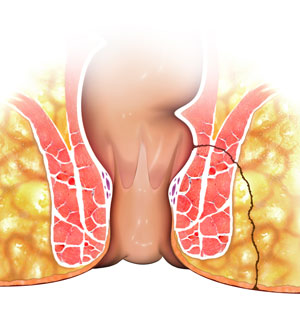Perianal Fistulae

Introduction
The anus is an external opening through which faeces is expelled out of your body. There are a number of small glands inside the anus between two muscles. These glands may sometimes get blocked and form a collection of pus called an abscess. Abscess then can break open into the anal canal or outside resulting in a fistula. An anal fistula is a small channel or tunnel that develops from the infected gland and opens out onto the skin near the anus.
Some fistulae have only one opening, while others are branched out into many openings. Fistulae may sometimes involve the sphincter muscles, the muscles that open and close the anus. The ends of the fistulae look like holes on the surface of the skin around the anus. Anal fistulas are commonly treated through surgery.
Signs and symptoms
The commonly observed symptoms of an anal fistula include:
- Throbbing pain that may get severe when sitting
- Irritation of the skin around the anus
- Swelling, tenderness, redness
- Bleeding
- Constipation
- Discharge of pus
- Pain during bowel movement
- Fever and fatigue
Diagnosis
Your doctor may review your medical history and conduct a physical examination to find the opening of the fistula. This will help your doctor trace the path of the channel, which can usually be felt as a hard cord-like structure below the skin. A digital rectal examination (insertion of a gloved finger through your anus) may be performed to find the internal opening of the fistula, the presence of any branching and the functioning of the sphincter muscles. Further examinations may be performed with the use of a fistula probe (a tiny instrument inserted into the rectum) and a proctoscope (a lighted device). Your doctor may recommend an ultrasound, CT or MRI scan for complicated fistulae with many branches, to evaluate the exact position of the fistula channels.
Treatment
As part of the pre-surgical process, you will be advised to stop smoking, fast for about 6 hours before the surgery, and you will be given an enema an hour before the surgery to empty your lower bowel. Anal fistula surgery is performed under general anaesthesia. The type of operation depends on the position of the fistula.
Seton technique: The seton technique involves passing a surgical thread into the fistula tract and leaving it in place for several months or permanently. This helps to keep the tract open and drain the contents of the fistula.
LIFT procedure: This procedure involves finding the fistula tract and dividing the fistula tract in between the two muscles and closing the wound.
Advancement flap procedures: This procedure is usually preferred if the fistula is complex or if you are at a high risk of developing incontinence. A small piece of tissue (advancement flap) is removed from the rectum or from the skin around the anus and attached over the opening of the fistula.
Fistulotomy: The surgery involves cutting open the fistula tract across its whole length. This is done for simple fistula with minimal muscle involvement. It heals into a flattened scar after 1 – 2 months.
Post-operative care
After the surgical procedure, your doctor will discharge you from the hospital on the same day or after a few days based on your condition. It might take 6 weeks for the wound to heal completely. The doctor may prescribe painkillers, antibiotics and laxatives. You will be advised to carefully wash, clean and dry your anal area. You are advised not to sit for long periods and walk much until healing occurs.








